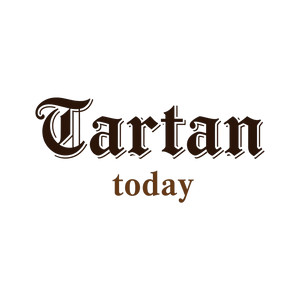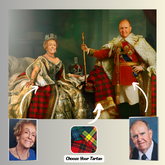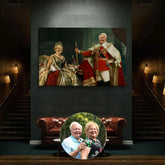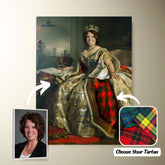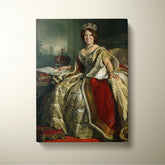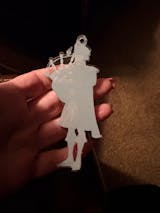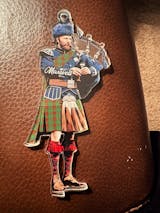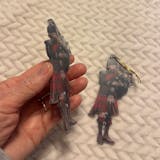-
Personalized Clan Ainslie Tartan Drummer Ornament with Custom Name – Scottish Christmas Tree Decoration VJ60
Personalized Clan Ainslie Tartan Drummer Ornament with Custom Name – Scottish Christmas Tree Decoration VJ60Celebrate your Scottish heritage with this unique wood & acrylic tartan ornament. Perfect as a personalized Christmas decoration or a meaningful gift for friends and relatives on special occasions such...- From $19.99 USD
$25.99 USD- From $19.99 USD
- Unit price
- per
Save $6.00 -
Personalized Clan Lake Ainslie Reproduction Tartan Bagpipe Ornament with Custom Name – Scottish Christmas Tree Decoration OT57
Personalized Clan Lake Ainslie Reproduction Tartan Bagpipe Ornament with Custom Name – Scottish Christmas Tree Decoration OT57Celebrate your Scottish heritage with this unique wood & acrylic tartan ornament. Perfect as a personalized Christmas decoration or a meaningful gift for friends and relatives on special...- From $19.99 USD
$25.99 USD- From $19.99 USD
- Unit price
- per
Save $6.00 -
Personalized Clan Lake Ainslie Modern Tartan Bagpipe Ornament with Custom Name – Scottish Christmas Tree Decoration TX43
Personalized Clan Lake Ainslie Modern Tartan Bagpipe Ornament with Custom Name – Scottish Christmas Tree Decoration TX43Celebrate your Scottish heritage with this unique wood & acrylic tartan ornament. Perfect as a personalized Christmas decoration or a meaningful gift for friends and relatives on special...- From $19.99 USD
$25.99 USD- From $19.99 USD
- Unit price
- per
Save $6.00 -
Personalized Clan Lake Ainslie Ancient Tartan Bagpipe Ornament with Custom Name – Scottish Christmas Tree Decoration KW45
Personalized Clan Lake Ainslie Ancient Tartan Bagpipe Ornament with Custom Name – Scottish Christmas Tree Decoration KW45Celebrate your Scottish heritage with this unique wood & acrylic tartan ornament. Perfect as a personalized Christmas decoration or a meaningful gift for friends and relatives on special...- From $19.99 USD
$25.99 USD- From $19.99 USD
- Unit price
- per
Save $6.00 -
Personalized Clan Ainslie Tartan Bagpipe Ornament with Custom Name – Scottish Christmas Tree Decoration NS32
Personalized Clan Ainslie Tartan Bagpipe Ornament with Custom Name – Scottish Christmas Tree Decoration NS32Celebrate your Scottish heritage with this unique wood & acrylic tartan ornament. Perfect as a personalized Christmas decoration or a meaningful gift for friends and relatives on special occasions such...- From $19.99 USD
$25.99 USD- From $19.99 USD
- Unit price
- per
Save $6.00 -
Personalized Clan Ainslie Reproduction Tartan Bagpipe Ornament with Custom Name – Scottish Christmas Tree Decoration VO53
Personalized Clan Ainslie Reproduction Tartan Bagpipe Ornament with Custom Name – Scottish Christmas Tree Decoration VO53Celebrate your Scottish heritage with this unique wood & acrylic tartan ornament. Perfect as a personalized Christmas decoration or a meaningful gift for friends and relatives on special occasions...- From $19.99 USD
$25.99 USD- From $19.99 USD
- Unit price
- per
Save $6.00 -
Personalized Clan Ainslie Modern Tartan Bagpipe Ornament with Custom Name – Scottish Christmas Tree Decoration IM64
Personalized Clan Ainslie Modern Tartan Bagpipe Ornament with Custom Name – Scottish Christmas Tree Decoration IM64Celebrate your Scottish heritage with this unique wood & acrylic tartan ornament. Perfect as a personalized Christmas decoration or a meaningful gift for friends and relatives on special occasions...- From $19.99 USD
$25.99 USD- From $19.99 USD
- Unit price
- per
Save $6.00 -
Personalized Clan Ainslie Lake District Reproduction Tartan Bagpipe Ornament with Custom Name – Scottish Christmas Tree Decoration SV29
Personalized Clan Ainslie Lake District Reproduction Tartan Bagpipe Ornament with Custom Name – Scottish Christmas Tree Decoration SV29Celebrate your Scottish heritage with this unique wood & acrylic tartan ornament. Perfect as a personalized Christmas decoration or a meaningful gift for friends and relatives on...- From $19.99 USD
$25.99 USD- From $19.99 USD
- Unit price
- per
Save $6.00 -
Personalized Clan Ainslie Lake District Modern Tartan Bagpipe Ornament with Custom Name – Scottish Christmas Tree Decoration UQ74
Personalized Clan Ainslie Lake District Modern Tartan Bagpipe Ornament with Custom Name – Scottish Christmas Tree Decoration UQ74Celebrate your Scottish heritage with this unique wood & acrylic tartan ornament. Perfect as a personalized Christmas decoration or a meaningful gift for friends and relatives on...- From $19.99 USD
$25.99 USD- From $19.99 USD
- Unit price
- per
Save $6.00 -
Personalized Clan Ainslie Lake District Ancient Tartan Bagpipe Ornament with Custom Name – Scottish Christmas Tree Decoration BV79
Personalized Clan Ainslie Lake District Ancient Tartan Bagpipe Ornament with Custom Name – Scottish Christmas Tree Decoration BV79Celebrate your Scottish heritage with this unique wood & acrylic tartan ornament. Perfect as a personalized Christmas decoration or a meaningful gift for friends and relatives on...- From $19.99 USD
$25.99 USD- From $19.99 USD
- Unit price
- per
Save $6.00 -
Personalized Clan Ainslie Ancient Tartan Bagpipe Ornament with Custom Name – Scottish Christmas Tree Decoration OE48
Personalized Clan Ainslie Ancient Tartan Bagpipe Ornament with Custom Name – Scottish Christmas Tree Decoration OE48Celebrate your Scottish heritage with this unique wood & acrylic tartan ornament. Perfect as a personalized Christmas decoration or a meaningful gift for friends and relatives on special occasions...- From $19.99 USD
$25.99 USD- From $19.99 USD
- Unit price
- per
Save $6.00 -
Personalized Clan Ainslie 1992 Variant Reproduction Tartan Bagpipe Ornament with Custom Name – Scottish Christmas Tree Decoration FJ68
Personalized Clan Ainslie 1992 Variant Reproduction Tartan Bagpipe Ornament with Custom Name – Scottish Christmas Tree Decoration FJ68Celebrate your Scottish heritage with this unique wood & acrylic tartan ornament. Perfect as a personalized Christmas decoration or a meaningful gift for friends and relatives on...- From $19.99 USD
$25.99 USD- From $19.99 USD
- Unit price
- per
Save $6.00 -
Personalized Clan Ainslie 1992 Variant Modern Tartan Bagpipe Ornament with Custom Name – Scottish Christmas Tree Decoration AY77
Personalized Clan Ainslie 1992 Variant Modern Tartan Bagpipe Ornament with Custom Name – Scottish Christmas Tree Decoration AY77Celebrate your Scottish heritage with this unique wood & acrylic tartan ornament. Perfect as a personalized Christmas decoration or a meaningful gift for friends and relatives on...- From $19.99 USD
$25.99 USD- From $19.99 USD
- Unit price
- per
Save $6.00 -
Personalized Clan Ainslie 1992 Variant Ancient Tartan Bagpipe Ornament with Custom Name – Scottish Christmas Tree Decoration MR98
Personalized Clan Ainslie 1992 Variant Ancient Tartan Bagpipe Ornament with Custom Name – Scottish Christmas Tree Decoration MR98Celebrate your Scottish heritage with this unique wood & acrylic tartan ornament. Perfect as a personalized Christmas decoration or a meaningful gift for friends and relatives on...- From $19.99 USD
$25.99 USD- From $19.99 USD
- Unit price
- per
Save $6.00 -
Personalized Clan Ainslie Tartan Bagpipe Ornament with Custom Name – Scottish Christmas Tree Decoration RR85
Personalized Clan Ainslie Tartan Bagpipe Ornament with Custom Name – Scottish Christmas Tree Decoration RR85Celebrate your Scottish heritage with this unique wood & acrylic tartan ornament. Perfect as a personalized Christmas decoration or a meaningful gift for friends and relatives on special occasions such...- From $19.99 USD
$25.99 USD- From $19.99 USD
- Unit price
- per
Save $6.00 -
Personalized Clan Ainslie Clan Crest Tartan Santa Ornament – Custom Acrylic Christmas Decoration GF53 - Ainslie
Personalized Clan Ainslie Clan Badge Tartan Ornament – Custom Acrylic Christmas Decoration GF53Celebrate your Scottish heritage with this unique wood & acrylic tartan ornament. Perfect as a personalized Christmas decoration or a meaningful gift for friends and relatives on special occasions such as Christmas,...- From $19.99 USD
- From $19.99 USD
- Unit price
- per
-
Ainslie
-
Personalized Clan Ainslie Modern Clan Crest Tartan Santa Ornament – Custom Acrylic Christmas Decoration MN50 - Ainslie
Personalized Clan Ainslie Modern Clan Badge Tartan Ornament – Custom Acrylic Christmas Decoration MN50Celebrate your Scottish heritage with this unique wood & acrylic tartan ornament. Perfect as a personalized Christmas decoration or a meaningful gift for friends and relatives on special occasions such as...- From $19.99 USD
- From $19.99 USD
- Unit price
- per
-
Ainslie
-
Personalized Clan Ainslie Ancient Clan Crest Tartan Santa Ornament – Custom Acrylic Christmas Decoration DM42 - Ainslie
Personalized Clan Ainslie Ancient Clan Badge Tartan Ornament – Custom Acrylic Christmas Decoration DM42Celebrate your Scottish heritage with this unique wood & acrylic tartan ornament. Perfect as a personalized Christmas decoration or a meaningful gift for friends and relatives on special occasions such as...- From $19.99 USD
- From $19.99 USD
- Unit price
- per
-
Ainslie
-
Personalized Clan Ainslie Weathered Clan Crest Tartan Santa Ornament – Custom Acrylic Christmas Decoration GE37 - Ainslie
Personalized Clan Ainslie Weathered Clan Badge Tartan Ornament – Custom Acrylic Christmas Decoration GE37Celebrate your Scottish heritage with this unique wood & acrylic tartan ornament. Perfect as a personalized Christmas decoration or a meaningful gift for friends and relatives on special occasions such as...- From $19.99 USD
- From $19.99 USD
- Unit price
- per
-
Ainslie
-
Personalized Clan Ainslie Clan Crest Tartan Santa Ornament – Custom Acrylic Christmas Decoration CP57 - Ainslie
Personalized Clan Ainslie Clan Badge Tartan Ornament – Custom Acrylic Christmas Decoration CP57Celebrate your Scottish heritage with this unique wood & acrylic tartan ornament. Perfect as a personalized Christmas decoration or a meaningful gift for friends and relatives on special occasions such as Christmas,...- From $19.99 USD
- From $19.99 USD
- Unit price
- per
-
Ainslie
Ex: Your Tartan + Product
Popular Products
Turn Me Royal Personalized Portrait from Your Photo, Custom Tartan. Custom Canvas Wall Art as Gift for Men
- From $32.45 USD
- From $32.45 USD
- Unit price
- / per
Royalty Couple Personalized Portrait from Your Photo, Custom Tartan. Custom Canvas Wall Art
- From $47.45 USD
- From $47.45 USD
- Unit price
- / per
The Queen Personalized Portrait from Your Photo, Custom Tartan. Custom Canvas Wall Art as Gift for Women
- From $32.45 USD
- From $32.45 USD
- Unit price
- / per
Which Clan Are You From?
- Ainslie
- Ainslie 01
- Ainslie 02
- Ainslie 1992 Variant Ancient
- Ainslie 1992 Variant Modern
- Ainslie 1992 Variant Reproduction
- Ainslie 2
- Ainslie Ancient
- Ainslie clanAinslie tartanApron
- Ainslie clanAinslie tartanPillow Cover
- Ainslie Gnome
- Ainslie Lake District Ancient
- Ainslie Lake District Modern
- Ainslie Lake District Reproduction
- Ainslie Modern
- Ainslie Reproduction
- Ainslie Tartan
- Ainslie Weathered
- Lake Ainslie Ancient
- Lake Ainslie Modern
- Lake Ainslie Reproduction
- Scott
List Of Tartan
-
Clan A
- Abercrombie Tartan
- Aberdeen Tartan
- Abernethy Tartan
- Adair Tartan
- Adam Tartan
- Ayrshire Tartan
- Agnew Tartan
- Aikenhead Tartan
- Ainslie Tartan
- Aiton Tartan
- Allan Tartan
- Alexander Tartan
- Allardice Tartan
- Allison Tartan
- Anderson Tartan
- Angus Tartan
- Anstruther Tartan
- Arbuthnot Tartan
- Armstrong Tartan
- Arnott Tartan
- Auchinleck Tartan
- Ayrshire Tartan
-
Clan B
- Baillie Tartan
- Bain Tartan
- Baird Tartan
- Balfour Tartan
- Bannatyne Tartan
- Bannerman Tartan
- Barclay Tartan
- Baxter Tartan
- Beaton Tartan
- Bell Tartan
- Belshes Tartan
- Bethune Tartan
- Beveridge Tartan
- Binning Tartan
- Bisset Tartan
- Blackadder Tartan
- Blackstock Tartan
- Black Watch Tartan
- Blair Tartan
- Blane Tartan
- Blyth Tartan
- Borthwick Tartan
- Boswell Tartan
- Bowie Tartan
- Boyd Tartan
- Boyle Tartan
- Brisbane Tartan
- Brodie Tartan
- Brown/ Broun Tartan
- Bruce Tartan
- Buccleuch Tartan
- Buchan Tartan
- Buchanan Tartan
- Burnett Tartan
- Burns Tartan
- Butter Tartan
- Byres Tartan
-
Clan C
- Cairns Tartan
- Calder Tartan
- Callander Tartan
- Cameron Tartan
- Campbell Tartan
- Campbell of Breadalbane Tartan
- Campbell of Cawdor Tartan
- Carmichael Tartan
- Carnegie Tartan
- Carruthers Tartan
- Cathcart Tartan
- Chalmers Tartan
- Charteris Tartan
- Chattan Tartan
- Cheyne Tartan
- Chisholm Tartan
- Christie Tartan
- Clark Tartan
- Clelland Tartan
- Clephan Tartan
- Clergy Tartan
- Cochrane Tartan
- Cockburn Tartan
- Colquhoun Tartan
- Colville Tartan
- Cooper Tartan
- Couper Tartan
- Craig Tartan
- Cranstoun Tartan
- Crawford Tartan
- Crichton Tartan
- Crief District Tartan
- Crosbie Tartan
- Cumming Tartan
- Cunningham Tartan
- Currie Tartan
- Clan D
- Clan E
- Clan F
- Clan G
- Clan H
- Clan I
- Clan J
- Clan K
- Clan L
-
Clan M
- Maitland Tartan
- Malcolm Tartan
- Mar Tartan
- Marjoribanks Tartan
- Maxtone Tartan
- Matheson Tartan
- Maule Tartan
- Maxwell Tartan
- Meldrum Tartan
- Melville Tartan
- Menzies Tartan
- Mercer Tartan
- Middleton Tartan
- Moffat Tartan
- Moncrieffe Tartan
- Montgomery Tartan
- Monypenny Tartan
- Moncreiffe Tartan
- Monteith Tartan
- Morrison Tartan
- Mouat Tartan
- Moubray Tartan
- Mow Tartan
- Muir_More Tartan
- Muirhead Tartan
- Munro Tartan
- Murray Tartan
- Murray of Atholl Tartan
-
Clan Mc/Mac
- MacAlister Tartan
- MacArthur Tartan
- MacAlpine Tartan
- MacAulay Tartan
- MacBain Tartan
- MacBean Tartan
- MacBeth Tartan
- MacCallum Tartan
- MacCraig Tartan
- MacColl Tartan
- MacCorquodale Tartan
- MacDiarmid Tartan
- MacDonald Tartan
- MacDonald of Clanranald Tartan
- MacDonald of Sleat Tartan
- MacDonnell of Glengarry Tartan
- MacDonnell of Keppoch Tartan
- MacDougall Tartan
- MacDowall Tartan
- MacDuff Tartan
- MacEwen_MacEwan Tartan
- MacEdward Tartan
- MacFarlane Tartan
- MacGill Tartan
- MacGillivray Tartan
- MacGregor Tartan
- MacGowan (McGowan) Tartan
- MacHardy Tartan
- MacIan Tartan
- MacInnes Tartan
- MacIntyre Tartan
- MacKay Tartan
- MacKillop Tartan
- MacKellar Tartan
- Mackinlay Tartan
- MacKenzie Tartan
- Mackie Tartan
- MacKinnon Tartan
- MacKintosh / MacIntosh Tartan
- MacLeod Tartan
- MacMillan Tartan
- MacNab Tartan
- MacNaughton Tartan
- MacNeil / MacNeill Tartan
- MacNeil of Colonsay Tartan
- MacNicol Tartan
- MacPhail Tartan
- MacPhee_MacFie Tartan
- MacPherson Tartan
- MacQuarrie Tartan
- MacQueen Tartan
- MacRae Tartan
- MacRow Tartan
- MacSporran Tartan
- MacTaggart Tartan
- MacTavish Tartan
- MacThomas Tartan
- McCorquodale Tartan
- McCulloch Tartan
- McFadzen Tartan
- McGeachie Tartan
- McIver Tartan
- McKerrell Tartan
- Clan N
- Clan O
- Clan P
- Clan R
-
Clan S
- Sandilands Tartan
- Scott Tartan
- Scrymgeour Tartan
- Selkirk Tartan
- Sempill Tartan
- Seton Tartan
- Shaw Tartan
- Shepherd Tartan
- Sinclair Tartan
- Skene Tartan
- Skirving Tartan
- Smith Tartan
- Somerville Tartan
- Spalding Tartan
- Spens Tartan
- Spottiswood Tartan
- Stevenson Tartan
- Stewart Tartan
- Stewart of Appin Tartan
- Stirling Tartan
- Strachan Tartan
- Straiton Tartan
- Strange Tartan
- Strathclyde District Tartan
- Stuart of Bute Tartan
- Sutherland Tartan
- Swinton Tartan
- Clan T
- Clan U W Y
- Request Your Clan
Clan Ainslie (Ainslie Tartan)
2. Clan Ainslie History
Most likely, Annesley in Nottinghamshire, England, is where the name Ainslie originates. Another Ansley, known as Hanslei in the Domesday Book of 1086, existed in Warwickshire.
Its name is a combination of the Old English words "ansetl," which means hermitage, and "leah," which means thin wood, glade, or clearing.
The Domesday Book refers to Annesley in Nottinghamshire as "Aneslei," which is derived from the Olde English "an," one, and "leah," as before, and means "the solitary glade." Therefore, Nottinghamshire is the most likely place for its origin.
Prior to the Norman Conquest, the surname Ainslie was common in England as well as Scotland's border regions. Ainslie, Ainsley, Aynsley, and Ainslee are the current spellings of the last name.
Thomas de Aneslei (1221, Glasgow), Johan de Anesleye (1296, Roxburghshire), and John de Annesley (1292, York) were the earliest known individuals with the surname Ainlie (or a derivative of it).
Large estates were held by the Saxon lords of Annesley in Nottinghamshire, but they fled to Scotland, where Malcolm III gave them a warm welcome, as William the Conqueror's army closed in.

The growing family soon settled in the areas of Dolphinstone. Around 1208, Walter, Bishop of Glasgow, witnessed a charter with William de Ainslie, a Glasgow Cathedral canon.
Thomas de Ainslie was one of the arbitrators chosen in 1221 to resolve a disagreement between the bishopric of Glasgow and the monks of Kelso.
A Borders knight named Sir Aymer de Aynesley was sent to negotiate with the English in attempt to settle the marches in 1249.
Two members of the family—John de Anesleye of Roxburghshire and Johan de Anesley of Cruwfurt in Laarkshire—are included in the Ragman Roll, which lists people who submitted to Edward I of England in 1296.
Between 1248 to 1254, Robert de Ainslie, Baron of Dolphinstone, accompanied Patrick, Earl of Dungar and March, on a crusade to the Holy Land. It appears likely that the crusader's son John was the Laird of Dolphinstone, who swore fealty to Edward I.
The Ainslies lost their estates as a result of opposing Robert the Bruce in his fight for the Scottish Crown.
But when William de Ainslie, who had wed Helen Kerr (of the line from which the current Duke of Roxburgh derives), became a favorite of Robert II, their situation changed. In 1377, the Dolphinstone lands were returned to William de Ainslie.
The Anisllies built their wealth by forging relationships with other illustrious Borders families through marriage. With the Kerrs, Homes, Pringles, and Douglases, they had several marriages.
Marjory, the son of John Ainslie, wed the ferocious combatant known as the Terror of the Borders, Mark Kerr of Cessford. At the Battle of Pinkie in 1547, he perished.

On January 13, 1766, Robert Ainslie was born. He was a Scottish writer and lawyer who served as Robert Burns's correspondent.
They met in Edinburgh in the spring of 1787, and together they walked through the Borders, with Ainslie being welcomed at Burns' home.eventually on, he paid Burns at Ellisland a visit and was given a manuscript copy of Tam o' Shanter, which he eventually sent to Sir Walter Scott.
One of his brothers, Sir Whitelaw Ainslie, was the medical director of India's Southern Division and the author of a thorough study of indigenous Indian medicine. He authored several plays and contributed frequently to the Edinburgh Magazine.
From 1776 to 1792, Sir Robert Ainslie served as the British ambassador in Constantinople to the Ottoman Empire. In 1804 he was made a baronet and served as a parliamentarian as well.
Three volumes of drawings and sketches of Egypt are now what most people remember him for.

Although they have attained great military position even more recently, the Ainslie arms unmistakably hint to their early crusading deeds.
The 93rd Highland Regiment, known today as the "Thin Red Line," was under the leadership of General Charles de Ainslie at the Battle of Balaclave in 1854.
The family also included eminent lawyers, and David Ainslie of Costerton, who passed away in 1900, gave money accumulated from his legal business to fund the construction of the Astley Ainslie Hospital in Edinburgh.
On the wall of the South Leith parish church is a memorial to the Ainslie family.

3. Clan Ainslie Tartans
If you'd like to arrange for a special weaving of the Ainslie Tartan, which cannot be done because it is a stock weave, please get in touch with us.
The district tartans are the most important because they are the source of the name.
Ainslie Tartan
Roxburgh District
Roxburgh Ancient
4. Clan Ainslie Crest & Coats of Arms
4.1 Clan Ainslie Crest
4.2 Clan Ainslie Coats of Arms
A word about coats of arms: According to Scottish heraldic law, an individual may be granted a coat of arms (with the exception of civic or corporate arms).
'Family coats of arms' don't exist. Except as noted above, the weapons shown below are personal weapons. The only person who is permitted to use these weapons is that person.
ARMS
Or, a cross flory Gules
ON COMPARTMENT
Pro patria saepe pro rege semper (For country often, for King always)
SUPPORTERS
Two knights in chain armor are positioned on a patch of thistles with a shield resting on a tree stump. The dexter knight is leaning on the shield with the beaver of his helmet up.
With a flowing pennon Azure, the crest is displayed in a canton Argent on an or shield with a cross flory Gules on one side and a spear and a skull cap on the other.

Ainslie of Great Torrington, baronets

Ainslie of Great Torrington, baronets
5. Clan Ainslie People & Places
5.1 Clan Ainslie People
Colonel Sir Philip Ainslie (1728-1802), KT., of Pilton

George Ainslie (d. 1773) and his wife Jane/Jean, a descendant of Sir Philip Anstruther, KT, had a second son, Philip Ainslie, who was born in Edinburgh in 1728.
George Ainslie died in 1773. Before enlisting in the army in 1754, Philip received his education at Westminster School.
While on duty in Portugal, he held the positions of Lt. Col. of cavalry, aide-de-camp to Prince Charles of Mecklenburg, and colonel of the 7th Dragoons. King George III knighted Ainslie on February 25, 1778.
Eight years later, in 1786, he took early retirement. He passed away in Edinburgh, where he had spent his final years, in 1802 at the age of 74. The Hon.
Elizabeth (d. 1787), a daughter of John, the 11th Lord Gray, and Philip Ainslie were wed on March 15th, 1772 in Edinburgh.
General George Robert Ainslie and Margaret Jane Ainslie were two of the many children Philip and Elizabeth had. Margaret Jane Ainslie later married Francis Stuart, the 10th Earl of Moray, in 1801 and had three children with him.
Reverend George Ainslie (1804-1875)

Anglican priest George Ainslie lived in the nineteenth century. He passed away on May 14th, 1875, when he was 71 years old.
7. The Captivating History of Clan Ainslie and the Distinguished Ainslie Tartan
The Ainslie Tartan and Clan Ainslie hold a significant place in Scottish history and culture. With its mesmerizing blue, green, and red stripes, the Ainslie Tartan represents loyalty, bravery, and a deep bond with the stunning Scottish landscapes.
The Ainslie clan, dating back to the 12th century, has a rich lineage entwined with Scotland's past, including their support for Robert the Bruce, the Covenanters, and their involvement in the Jacobite uprisings.
Today, the Ainslie Tartan proudly represents the clan's connection to its Scottish heritage.
Explore the captivating history of Clan Ainslie and the distinguished Ainslie Tartan, uncovering the origins of the Ainslie name, their migration to Scotland, and their prosperous genealogy.
8. Unraveling the Origins of the Ainslie Name
The Ainslie name likely derives from Annelsey in Nottinghamshire, England. The name has undergone various spellings over the centuries, including Ansley, Ainsley, and Aynsley.
The exact origin of the name remains somewhat uncertain, but it is believed to have originated from the Old English word "an" meaning "at" and "lea" meaning "clearing" or "field." This suggests that the name refers to someone from the clearing or field by the river Annesley.
9. Migration of the Ainslie Family to Scotland
The Ainslie family migrated to Scotland during a time of political and social upheaval. They settled in the breathtaking lands around Dolphinstone, which provided fertile ground for their future endeavors.
The migration of the Ainslie family to Scotland marked the beginning of their deep connection with the country and their integration into Scottish society.
10. Settling in the Breathtaking Lands of Dolphinstone
The lands around Dolphinstone, where the Ainslie family settled, are known for their awe-inspiring beauty.
Nestled amidst rolling hills, lush greenery, and enchanting rivers, this region offered the Ainslie clan a tranquil and picturesque environment.
The family embraced this breathtaking landscape and made it their home for generations to come.
11. The Clan Ainslie Crest and Proudly Showcasing Products
The Clan Ainslie crest is a symbol of the family's heritage, values, and achievements. It consists of various elements that represent the clan's history and aspirations.
From kilts and scarves to fabrics and beyond, a wide range of products proudly display the Clan Ainslie crest.
These products not only celebrate the Ainslie name but also allow individuals to connect with their Scottish roots and showcase their pride in belonging to the clan.
12. A Journey Through the Prosperous Heritage and Genealogy of the Ainslie Clan
Delving into the prosperous heritage and genealogy of the Ainslie clan unveils a tapestry of Scottish history intertwined with their legacy.
From their support for Robert the Bruce, who fought for Scottish independence in the 14th century, to their allegiance to the Covenanters during the religious conflicts of the 17th century, the Ainslies played a significant role in shaping Scotland's destiny.
Their involvement in the Jacobite uprisings further solidified their place in Scottish history.
13. Tracing Ties to the Esteemed Border Reiver Family Legacy
The Ainslie clan's connection to the esteemed Border Reiver family legacy adds another layer of intrigue to their history.
Border Reivers were notorious clans who lived along the Anglo-Scottish border, engaging in raids and acts of defiance.
The Ainslies were known for their resilience and resourcefulness in the face of these challenging times, ultimately establishing themselves as a prominent border family.
14. Connecting with Fellow Enthusiasts of the Ainslie Name
Joining the Council of Scottish Clans & Associations allows individuals with an affinity for the Ainslie name to connect with fellow enthusiasts.
This council brings together individuals who share a deep passion for Scottish heritage and provides opportunities for networking, learning, and celebrating shared traditions.
By joining this council, enthusiasts can forge new connections and strengthen their ties to the Ainslie clan.
15. Embracing the Allure of Clan Ainslie and the Ainslie Tartan
The allure of Clan Ainslie and the Ainslie Tartan lies in their ability to evoke a sense of pride, belonging, and cultural heritage.
By embracing the clan's history and the significance of the tartan, individuals can connect with their Scottish roots on a deep and personal level.
The Ainslie Tartan serves as a powerful emblem of Scottish pride and heritage, reminding clan members of their shared history and the enduring legacy they uphold.
16. Embodying Loyalty, Bravery, and a Profound Bond with Scottish Landscapes
The Ainslie Tartan's mesmerizing blue, green, and red stripes embody essential values cherished by the clan.
These colors represent loyalty, bravery, and a profound bond with the Scottish landscapes that have shaped the Ainslie identity throughout history.
Donning the Ainslie Tartan allows individuals to express their allegiance to these values while paying homage to their Scottish ancestry.
17. Embracing an Extensive Range of Ainslie Tartan Products
An extensive range of Ainslie Tartan products is available for those seeking to celebrate their Scottish heritage and connect with the Ainslie clan.
From kilts and scarves to fabrics and accessories, these products showcase the timeless elegance and beauty of the Ainslie Tartan.
Each item not only serves as a stylish addition to one's wardrobe but also serves as a tangible representation of the rich history and heritage associated with the Ainslie clan.
18. Cherishing the Timeless Elegance of the Ainslie Tartan
The enduring legacy of the Ainslie Tartan lies in its timeless elegance. The combination of colors and patterns in the tartan design reflects both the Ainslie clan's history and the aesthetic appeal of Scottish culture.
Whether worn as a kilt, scarf, or incorporated into home decor, the Ainslie Tartan adds a touch of sophistication and cultural pride to any setting.
19. FAQs
19.1 How can I join the Council of Scottish Clans & Associations?
To join the Council of Scottish Clans & Associations, visit their official website and follow the membership registration process. Fill out the required information and pay the membership fee to become a member.
Once you are a member, you can actively participate in the council's activities and connect with fellow Ainslie enthusiasts.
19.2 Can I wear the Ainslie Tartan even if I'm not part of the clan?
Absolutely! The Ainslie Tartan is not exclusive to clan members. It is a symbol of Scottish heritage and can be worn by anyone who wishes to connect with their Scottish roots or appreciates the beauty and history of the tartan.
Embrace the Ainslie Tartan and enjoy its timeless elegance.
19.3 Are there any events or gatherings specifically for Clan Ainslie members?
Yes, there are events and gatherings specifically tailored for Clan Ainslie members. These events provide an opportunity to connect with other clan members, celebrate shared traditions, and learn more about the Ainslie heritage.
Keep an eye on the Council of Scottish Clans & Associations website for updates on upcoming events.
19.4 Can I trace my ancestry back to the Ainslie clan?
It is certainly possible to trace your ancestry back to the Ainslie clan. Several resources, such as genealogical records, DNA testing, and historical archives, can assist you in unraveling your family history.
Engaging the services of a professional genealogist can also provide valuable insights into your lineage and potential connections to the Ainslie clan.
19.5 What other clans have connections to Clan Ainslie?
Clan Ainslie has connections to various other clans and families within the Scottish Borders region, including the Armstrong, Scott, Maxwell, and Elliot clans, among others.
These connections stem from shared histories, alliances, and intermarriages between clans over the centuries.
19.6 Where can I find authentic Ainslie Tartan products?
Authentic Ainslie Tartan products can be found at reputable Scottish retailers, both online and in physical stores.
It is essential to ensure that the products you purchase are made with genuine Ainslie Tartan fabric, reflecting the accuracy and quality associated with the clan's heritage.
Searching for well-established Scottish retailers and merchants specializing in tartan products is a good starting point.
20. Conclusion
Embarking on a voyage of discovery into the captivating history of Clan Ainslie and the distinguished Ainslie Tartan allows individuals to connect with their Scottish heritage in a profound way.
From unraveling the origins of the Ainslie name to tracing the clan's prosperous genealogy, every aspect of this journey unveils the enduring legacy and significance of Clan Ainslie.
Whether by joining the Council of Scottish Clans & Associations or embracing the Ainslie Tartan, individuals can honor the rich history and heritage associated with the Ainslie name.
Embrace the allure of Clan Ainslie and the Ainslie Tartan and forge a deep connection with Scottish pride and heritage.
- Choosing a selection results in a full page refresh.
